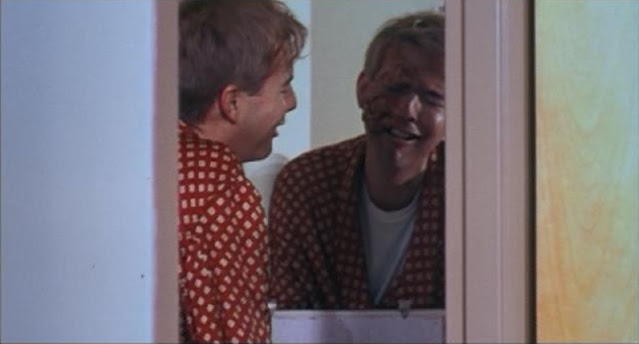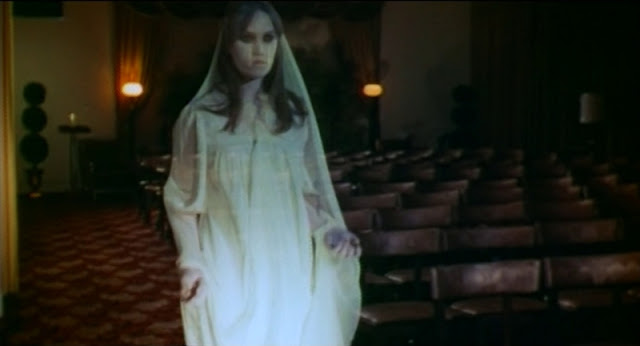The times, they were a-changing. Ira Levin’s 1972 novel The
Stepford Wives,* reflected the evolving sociopolitical climate of the
turbulent late ‘60s and early ‘70s, when many women, tired of being regarded as
second-class citizens, and shackled by domestic life, demanded more. At the
same time, they faced a backlash from those who wanted to preserve the status quo
and keep them in the kitchens. Although Levin didn’t consciously intend to
write a story with overt social commentary, his novel astutely captured the
growing war between the sexes, through a satirical lens. Another layer of
Levin’s novel (underscored in the 1975 film), was the “white flight” of
upwardly mobile (predominately Caucasian) families from the densely populated,
racially/ethnically diverse cities to the more vanilla, WASP-centric suburbs.
Levin used his experience living in the suburban Connecticut town of Wilton as
a template for his picture-postcard, Norman Rockwell-esque town of Stepford.
* Fun Fact: The Stepford Wives started as a play,
which eventually evolved into a novel.
Enter our protagonist, Joanna Eberhart, a smart, independent
woman with aspirations of becoming a professional photographer. She
begrudgingly acquiesces to her husband Walter’s desire to transplant their
family to Stepford, and its quaintly manufactured trappings. With a couple of
notable exceptions, she fails to connect with the women of Stepford, and their
single-minded obsession with housekeeping. The move only exacerbates the divide
between Joanna and Walter, when he spends more and more time away from the
house, working long hours in the office or cavorting with his new chums at the shadowy
Stepford Men’s Association. But beneath the “boys will be boys” veneer lies
something much more sinister.
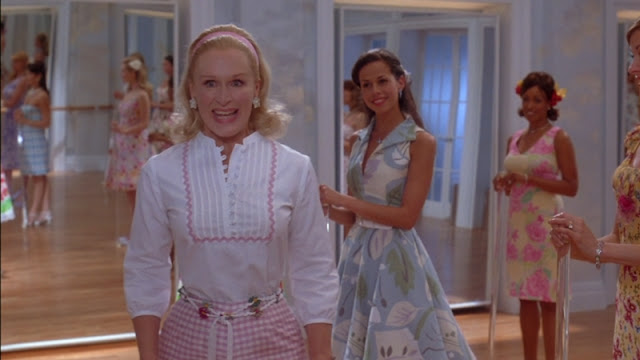
Levin’s novel endures, not only because it’s a taut,
well-crafted thriller, but because its core implications are just as relevant
today. “Stepford” and “Stepford Wife” have entered our general lexicon, to
describe something (or someone) as bland, pre-programmed, or homogenous. The
current climate is equally ripe for satire, with the alarming rise of groups
that would prefer to return to a mythical, “great” time in America’s past, when
(predominately white, heterosexual) men were men and women knew their place. An
entire generation separated the 1975 and 2004 film versions, which took wildly
divergent approaches. How successful was each respective film, in relation to
the source material? Let’s take a look…
The Stepford Wives (1975) Directed by Bryan Forbes;
Screenplay by William Goldman; Based on the novel by Ira Levin; Starring: Katherine
Ross, Paula Prentiss, Peter Masterson, Nanette Newman and Tina Louise;
Available on DVD
Rating: ****
"A lot of horror movies are dark and gloomy and sinister, but this was a horror that was in sunlight with beautiful surroundings and beautiful people. It made it so it lulled you along until it finally terrified you." – Nanette Newman (who appeared as Carol Van Sant in The Stepford Wives)

Joanna and Walter Eberhart (Katharine Ross and Peter
Masterson) leave the hustle and bustle of New York City to suburban
Connecticut, where life is simpler and the pace is slower. Something, however,
isn’t quite right in the seemingly idyllic domestic world of Stepford (filmed
in Darien and Fairfield, CT). Joanna* immediately feels alienated by the
cleaning-obsessed housewives and their selfless devotion, catering to their
husbands’ every whim.** But as Joanna is repelled by Stepford, Walter seems
immediately at home, joining the exclusive Stepford Men’s Association. They
carry out their meetings, sequestered in a 19th century mansion,
away from the eyes of their spouses, who dress like they belong in Leave it
to Beaver. Joanna finds comradeship in two other independent spirits, Bobby
Markowe (Paula Prentiss) and Charmaine Wimpiris (Tina Louise), but their
alliance proves to be short-lived when both friends seemingly transform into
mindless housewives overnight.*** Soon, it’s Joanna against the rest of the
town.
* Fun Fact #1: Before Ross landed the role, Jeanne Seberg,
Diane Keaton, and Tuesday Weld were considered for Joanna Eberhart.
** Fun Fact #2: Levin, himself, wasn’t terribly pleased with
the results, asserting the filmmakers missed the point: “In Stepford, the women
would have been in hot pants and the men would have been at a softball game
with the women bringing them cold beer.” (from 2002 Los Angeles Times
interview)
*** Fun Fact #3: In the scene where Joanna stabs her friend
Bobbie’s doppelgänger, it’s not Ross’ hand but director Forbes.

The Stepford Wives lays bare the awful truth about
the “boys club” mentality, with the Men’s Association an antiquated
rationalization for misogynistic behavior. The men in the film, galvanized by
association leader Dale Coba (Patrick O’Neal), exert their considerable peer
pressure on Walter to fall in line. Through the dynamics of the group, the men
perpetrate what would be unthinkable as an individual. The Stepford men fear
women as equals, so they must keep them subordinated. In a brief moment of
vulnerability, Walter’s tearfully confesses his love to Joanna, but it’s not as
much an admission of spousal devotion as a resignation that he’s already sold
out. As Joanna gets closer to the truth behind Stepford’s patriarchal
conspiracy, her husband gaslights her at every step. The disturbing climax,
reinforced by the chilling final scene, suggests that suburbia has no place for
diversity or outliers.* In the town’s push for absolute conformity, there is no
escape.
* Fun Fact #4: Jordan Peele cited The Stepford Wives
as an inspiration for his own suburban nightmare film, Get Out.

In the world of The Stepford Wives, plausibility
takes a backseat to building a satire of Swiftian proportions (instead of
eating babies, they’re killing their wives). The women of Stepford are only
good as servants and sex objects – a terribly dull existence for life partners.
But the men of Stepford are equally vapid – they don’t want significant others
that are intellectual equals or display independence, they only desire
subordinates. And what about their children (as my wife pointed out)? It
wouldn’t take very long for the kids to notice something’s wrong with mom. But
exaggeration and contrast (tempered with a healthy suspension of disbelief) are
cornerstones of satire. While the film version makes some necessary omissions
and changes from book to screen, it remains largely faithful to the novel, underscoring
the wide chasm between the men and women of Stepford. The Stepford Wives
wasn’t met with unanimous praise upon its release, with some feminists decrying
it as anti-woman, but it’s since withstood the test of time. If nothing else,
it’s forced many to re-examine what a partnership means.
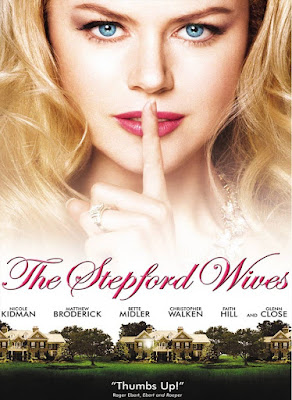
The Stepford Wives (2004) Directed by Frank Oz;
Screenplay by Paul Rudnick; Based on the novel by Ira Levin; Starring: Nicole
Kidman, Bette Midler, Matthew Broderick, Glenn Close, Christopher Walken, Roger
Bart and Jon Lovitz; Available on Blu-ray and DVD
Rating: **
“The Stepford Wives was too big and it was unsatisfying to do. Not that it was unsatisfying to do, but it was unsatisfying as a result, because as much as I loved parts of it, and I'm really proud of so much of it, the entire movie wasn't what I wanted it to be. It's my own fault, I didn't follow my instincts.” – Frank Oz (from 2007 AV Club interview with Nathan Rabin)
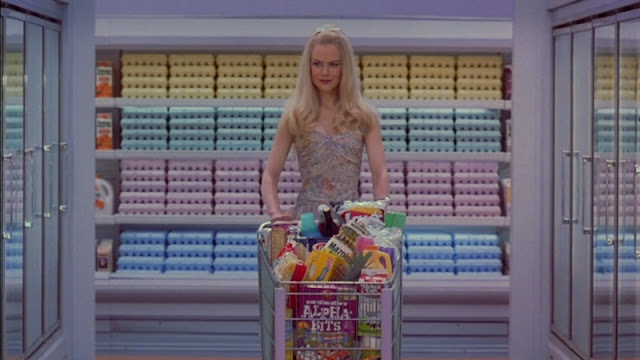
If the 1975 film version utilized Levin’s novel as a
template, the remake used the story as a springboard. But what should have been
a refreshing update proved to be a glaring weakness. Compared to the relatively
low budget of the original film, the $90 million remake seems bloated (other
than the sheen of Hollywood schmaltz and A-list actors, you’d be hard pressed
to find where the money went). Instead of depicting a modest, bucolic
neighborhood, the 2004 version goes one louder, making Stepford an exclusive
gated community filled with gaudy, soulless McMansions.
This could have been a good launching point for commentary about mass
consumerism and America’s “bigger is better” mentality, but the satirical
elements never go beyond the superficial.

A successful book adaptation doesn’t require slavish
devotion to the minutiae of the source material, but it should, at the very
least, capture its spirit. Somehow, the filmmakers made the wrong choices about
what to change every step of the way, starting with Joanna Eberhart (played by
the usually reliable Nicole Kidman). This version of Joanna (a producer of a
mean-spirited reality TV show) comes across as self-centered and unsympathetic.
Likewise, it’s difficult to buy Matthew Broderick as her would-be alpha male
husband. His character seems too wishy-washy to comply with the Stepford
conspiracy. When he ultimately musters the courage to stand up to the town’s
male leadership, it’s more of a plot contrivance than a natural progression of
the character. But one of the film’s greatest mistakes is showing its hand far
too soon. One of the wives begins to malfunction (sped up for “comic” effect)
at a barn dance, leaving no ambiguity about Stepford’s secret. Compare this to an
early scene in the 1975 version, in which one of the Stepford wives (following
a seemingly minor car accident in a supermarket parking lot) appears to be experiencing
a nervous breakdown. While her reaction seemed somewhat abnormal, given the
context, it was entirely plausible.

One bright spot in the remake is Bette Midler’s performance
as Joanna’s nonconformist neighbor Bobbie Markowitz,* who seems to be the only
character that could have been transplanted from the original film. Midler is obviously
having fun with the role, and delivers some of the best lines. Unfortunately, Midler
and Kidman don’t have nearly the same chemistry as Ross and Prentiss in the
original film. We’re forced to take their friendship at face value, when in
reality they’d probably never move in the same circles.
* Fun Fact #5: According to a 2002 Hollywood Reporter article,
Joan Cusack was originally cast to play Bobbie.
If the original film required suspension of disbelief, the
remake stretches our resilience to the breaking point. We’re never entirely clear
on where the film stands, with the transformation of the eponymous wives. Instead
of employing android duplicates, the Men’s Association uses computerized brain
implants to make the wives compliant. But when one of the wives pays out like a
cash machine, it’s clear there’s more than microchips in the mix. When we learn
that the effect of the neural implants is a reversible process, it takes the horror
out of the original premise.

(MAJOR SPOILER ALERT) Perhaps the greatest betrayal of Levin’s story is that the
source of the wifely switcheroo isn’t a male-led conspiracy, but the brainchild
of welcome wagon lady Claire Wellington (Glenn Close), who only wanted to preserve
the status quo. Instead of co-conspirators, the Stepford men (including her
husband, the Men’s Association leader) are nothing more than pawns. When we see
the Stepford husbands bumbling around in a supermarket towards the end of the
film, it’s an obvious nod to the original’s final scene, but it isn’t as much a
tribute as it’s a mockery. This is not to say that there couldn’t (or shouldn’t)
be a comic reimagining of The Stepford Wives, but the 2004 version lacks
the sardonic edge the material requires. Better luck next time?
Sources: “The Art of Darkness” (2002), The Los Angeles
Times, by Mary McNamara; “Cultural Studies; Stepping Out in Stepford Style,”
(2002), The New York Times, by Ginia Bellafante; “The Stepford Wives: Inside
the Making of the 1975 Feminist Horror Classic,” Entertainment Weekly, by Devan
Coggan (2022); Hollywood Reporter (Nov. 25, 2002); Frank Oz Interview (2007),
AV Club, by Nathan Rabin



